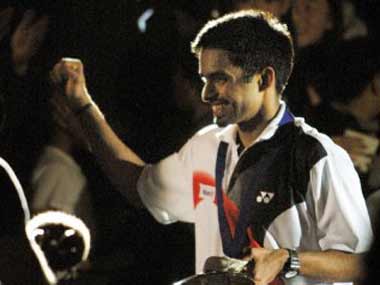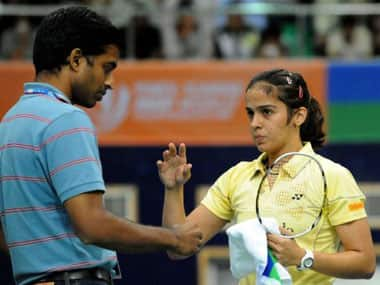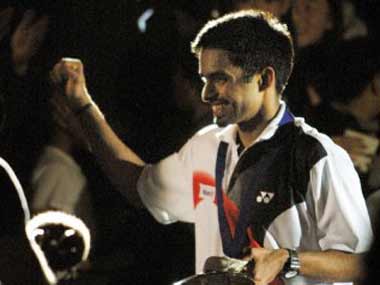For most of today’s generation which has witnessed Saina Nehwal’s rise to the top of world badminton, Pullela Gopi Chand remains best known as her coach. Those knowing a little more about the great champion also know that he won the All England title — arguably the greatest honour in the sport. But is that all to the man who in every sense has defied odds to become the champion that he was? How many of us know that it was Gopi who revolutionised the way badminton was played back then with his aggressive smashes and attacking style of play as against touch play? Former shuttler Sanjay Sharma and his daughter Shachi S Sharma have attempted to unravel Gopi’s courageous journey from his down-to-earth beginnings to becoming a name that even the mighty Chinese feared and his gradual progression towards coaching, in the yet-to-be-released authorised biography ‘Pullela Gopi Chand — The World Beneath His Feat’. [caption id=“attachment_152379” align=“alignleft” width=“380” caption=“A true hero - both on and off the court. Adrian Dennis/AFP”]
 [/caption] For someone who has interacted with Gopi several times over the last six years while covering the sport, I must admit there were quite a few interesting things about the Hyderabadi that I got to know from the book. It was interesting to note that badminton wasn’t Gopi’s first choice. Actually he and his older brother were quite keen on tennis but didn’t pursue the sport because the other boys who played at the Fateh Maidan Club in Hyderabad came from affluent backgrounds and his parents didn’t want the boys to get any sort of inferiority complex. Badminton, they thought, was a more lower-middle class sport. That their decision would change the course of their lives was something they had never imagined then. I was amused to know that a young Gopi was a huge Rajnikant fan, to the extent that he would impersonate the actor’s on-screen mannerisms by throwing toffees or chocolates (instead of cigarettes as Rajni did) in the air and catching them. The phase lasted a year and Gopi not only copied Rajni’s clothes, he also ate, drank and walked like the star. Gopi also only spoke Tamil as against Telugu, his mother tongue. As a child Gopi hated academics. Although he was good at English, Social Studies, Hindi and Biology, he wasn’t comfortable with Telugu and Physics. Maths gave him the toughest time. Gopi once even asked his neighbour, “Who invented this education and studies? Why do we have to waste so many hours in school when we can be out playing games?” [caption id=“attachment_152271” align=“alignright” width=“250” caption=“Scanned image of the book cover”]
[/caption] For someone who has interacted with Gopi several times over the last six years while covering the sport, I must admit there were quite a few interesting things about the Hyderabadi that I got to know from the book. It was interesting to note that badminton wasn’t Gopi’s first choice. Actually he and his older brother were quite keen on tennis but didn’t pursue the sport because the other boys who played at the Fateh Maidan Club in Hyderabad came from affluent backgrounds and his parents didn’t want the boys to get any sort of inferiority complex. Badminton, they thought, was a more lower-middle class sport. That their decision would change the course of their lives was something they had never imagined then. I was amused to know that a young Gopi was a huge Rajnikant fan, to the extent that he would impersonate the actor’s on-screen mannerisms by throwing toffees or chocolates (instead of cigarettes as Rajni did) in the air and catching them. The phase lasted a year and Gopi not only copied Rajni’s clothes, he also ate, drank and walked like the star. Gopi also only spoke Tamil as against Telugu, his mother tongue. As a child Gopi hated academics. Although he was good at English, Social Studies, Hindi and Biology, he wasn’t comfortable with Telugu and Physics. Maths gave him the toughest time. Gopi once even asked his neighbour, “Who invented this education and studies? Why do we have to waste so many hours in school when we can be out playing games?” [caption id=“attachment_152271” align=“alignright” width=“250” caption=“Scanned image of the book cover”]
 [/caption] His parents were fine with Gopi playing all day as long as he finished his homework and passed his exams. Even in those days, his parents understood and respected the fact that both their sons had different interests. And so, even as their older son (Raja Shekhar) was among the toppers in class, there was no pressure on Gopi to score high marks. Later on, when Raja got through to IIT Madras and Gopi was still struggling to make it big in badminton, his parents braved all taunts from the extended family and let Gopi pursue his dream. It’s known that Gopi came from a humble background but do we know that his mother, Subbaravamma, would walk 4-5 kms in the punishing Hyderabad summer just to save the one buck bus fare to buy her son a shuttle. She stopped socialising and didn’t watch a movie for 13 years so that the money could be used for Gopi’s kit or better food for him. In fact, Gopi’s father, P Subash Chandra Bose, would make do with just four shirts in a year to fulfil the never-ending demands of the game. But if there was a bigger sacrifice it was Gopi’s younger sister Hima Bindu, who was always denied clothes and books because of Gopi’s badminton needs. Of course, Gopi pampered her silly once he started doing well and always got her a gift when he went overseas. Gopi too was very understanding of the family’s situation and would bring back bags full of used shuttles from all international events to practice in Hyderabad as the Yonex ones cost a lot. Initially the custom officials were suspicious that Gopi was bringing back so many used shuttles for trading but when they were told the reason, they were quite amused. Continues on the next page Gopi always talks of the huge role his mother played in his career. He’s often said that had it not been for her, he would’ve never come back from the career-threatening knee injury and All England would’ve remained only a dream. The freak-injury had left Gopi on crutches and since his building had no elevator, his parents would carry him up and down the stairs on their shoulders. And as Gopi himself says in the book, “I was not a small boy and was quite heavy. But my parents never complained.” [caption id=“attachment_152260” align=“alignleft” width=“380” caption=“Gopi with his mother Subbaravamma at the Delhi airport after winning the 2001 All England title. AFP”]
[/caption] His parents were fine with Gopi playing all day as long as he finished his homework and passed his exams. Even in those days, his parents understood and respected the fact that both their sons had different interests. And so, even as their older son (Raja Shekhar) was among the toppers in class, there was no pressure on Gopi to score high marks. Later on, when Raja got through to IIT Madras and Gopi was still struggling to make it big in badminton, his parents braved all taunts from the extended family and let Gopi pursue his dream. It’s known that Gopi came from a humble background but do we know that his mother, Subbaravamma, would walk 4-5 kms in the punishing Hyderabad summer just to save the one buck bus fare to buy her son a shuttle. She stopped socialising and didn’t watch a movie for 13 years so that the money could be used for Gopi’s kit or better food for him. In fact, Gopi’s father, P Subash Chandra Bose, would make do with just four shirts in a year to fulfil the never-ending demands of the game. But if there was a bigger sacrifice it was Gopi’s younger sister Hima Bindu, who was always denied clothes and books because of Gopi’s badminton needs. Of course, Gopi pampered her silly once he started doing well and always got her a gift when he went overseas. Gopi too was very understanding of the family’s situation and would bring back bags full of used shuttles from all international events to practice in Hyderabad as the Yonex ones cost a lot. Initially the custom officials were suspicious that Gopi was bringing back so many used shuttles for trading but when they were told the reason, they were quite amused. Continues on the next page Gopi always talks of the huge role his mother played in his career. He’s often said that had it not been for her, he would’ve never come back from the career-threatening knee injury and All England would’ve remained only a dream. The freak-injury had left Gopi on crutches and since his building had no elevator, his parents would carry him up and down the stairs on their shoulders. And as Gopi himself says in the book, “I was not a small boy and was quite heavy. But my parents never complained.” [caption id=“attachment_152260” align=“alignleft” width=“380” caption=“Gopi with his mother Subbaravamma at the Delhi airport after winning the 2001 All England title. AFP”]
 [/caption] And if there was another person who lifted Gopi’s spirits whenever he doubted getting back on court again, it was the doctor who performed the knee surgery on him, Dr Ashok Rajgopal. The doctor had overheard Gopi’s parents say that they couldn’t afford Rs 15,000 for the surgery and waived off his entire fee. Just to make Gopi and his family feel better, Rajgopal said if Gopi ever won the All England, that would be his fee. In the backdrop of such struggle, it’s remarkable to note that Gopi refused to endorse a cola brand which would’ve fetched him a cool Rs 15 lakh, because his maid borrowed Rs 10 from him only to buy the cola for her ailing husband thinking the latter would start running just like the man in the ad! Gopi says he could never fool vulnerable people by endorsing things he didn’t believe in. The biography talks in great detail about Gopi’s formative years, the lack of structured coaching during those times, his single-minded dedication to badminton for which he literally lived like a monk, his peers, his struggles, his injuries, his coaches, his losses over which he cried for hours and later spied on his opponent’s training to know what extra he was doing, his initiation into Art Of Living and meditation, and ofcourse the Big moment in Birmingham. For all this and more grab a copy of the book as it provides a remarkable account of the makings of one of modern India’s sporting geniuses. What impresses you once you’ve finished the book is that even though he can now afford the luxuries of life, Gopi’s lifestyle and his dedication to badminton remains unchanged. His state-of-the-art academy at Gachibowli in Hyderabad, now worth about Rs 80 crores, is his gift to millions of budding players who now have all facilities under one roof, something Gopi never had. [caption id=“attachment_152280” align=“alignright” width=“380” caption=“Gopi with his most famous student, Saina Nehwal. AFP”]
[/caption] And if there was another person who lifted Gopi’s spirits whenever he doubted getting back on court again, it was the doctor who performed the knee surgery on him, Dr Ashok Rajgopal. The doctor had overheard Gopi’s parents say that they couldn’t afford Rs 15,000 for the surgery and waived off his entire fee. Just to make Gopi and his family feel better, Rajgopal said if Gopi ever won the All England, that would be his fee. In the backdrop of such struggle, it’s remarkable to note that Gopi refused to endorse a cola brand which would’ve fetched him a cool Rs 15 lakh, because his maid borrowed Rs 10 from him only to buy the cola for her ailing husband thinking the latter would start running just like the man in the ad! Gopi says he could never fool vulnerable people by endorsing things he didn’t believe in. The biography talks in great detail about Gopi’s formative years, the lack of structured coaching during those times, his single-minded dedication to badminton for which he literally lived like a monk, his peers, his struggles, his injuries, his coaches, his losses over which he cried for hours and later spied on his opponent’s training to know what extra he was doing, his initiation into Art Of Living and meditation, and ofcourse the Big moment in Birmingham. For all this and more grab a copy of the book as it provides a remarkable account of the makings of one of modern India’s sporting geniuses. What impresses you once you’ve finished the book is that even though he can now afford the luxuries of life, Gopi’s lifestyle and his dedication to badminton remains unchanged. His state-of-the-art academy at Gachibowli in Hyderabad, now worth about Rs 80 crores, is his gift to millions of budding players who now have all facilities under one roof, something Gopi never had. [caption id=“attachment_152280” align=“alignright” width=“380” caption=“Gopi with his most famous student, Saina Nehwal. AFP”]
 [/caption] As his wife and former shuttler PV Lakshmi says in the book, “Gopi is wedded more to badminton than me. But atleast now he takes me for a movie once every two months, provided I check that the reviews are good and book the tickets in advance.” Gopi’s already produced a Saina and he’s optimistic that there’s lot of talent around. The chuha, as Gopi and other juniors were called by his first coach Hamid Hussein, turned out to be the lion in the pack.
[/caption] As his wife and former shuttler PV Lakshmi says in the book, “Gopi is wedded more to badminton than me. But atleast now he takes me for a movie once every two months, provided I check that the reviews are good and book the tickets in advance.” Gopi’s already produced a Saina and he’s optimistic that there’s lot of talent around. The chuha, as Gopi and other juniors were called by his first coach Hamid Hussein, turned out to be the lion in the pack.
Gopi's rise: How parents supported a sports protege
Bagri
• December 9, 2011, 17:08:31 IST
In the yet-to-be-released biography ‘Pullela Gopi Chand — The World Beneath His Feat’, Sanjay Sharma and his daughter Shachi S Sharma have given a heart-rendering account of a boy and a family which struggled to make ends meet but then went on to conquer the world.
Advertisement
)
End of Article